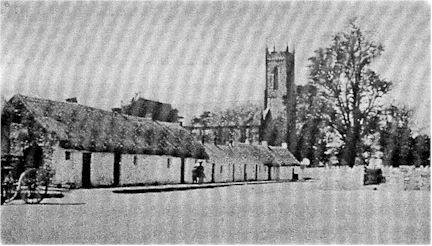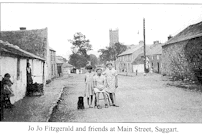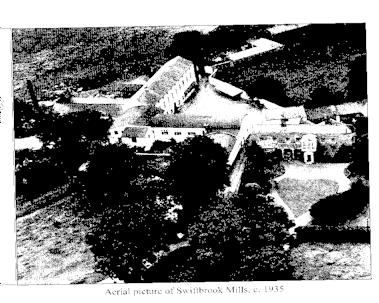History of Saggart

Saggart Village 1905
Origin of the Name
The village developed around a monastery founded by a monk
called Mosacra in the 7th century and some remains can still be seen near the
entrance to rhe burial ground opposite the church. TEACHSACRA means house of
Sacra. This also becane Tasagard, then Saggard and to-day Saggart. A church stood on the site of Mosacre's Monastery and was in use
until the late 1600s when it was noted to be in a ruinous state.Some remains of
the structrue were found during grave digging.
In the burial ground there is a large granite stone with a
double celtic cross in slight relief dating from the 10th century and is
known as the Pilgrims Stone.

Main street early 20th century.
Norman Times
King Henry 11 formed four Royal Manors out of land that
had belonged to the Danes at Newcastle, Saggart, Crumlin and Esker.That is how
the lands of Saggart and Rathcoole came to be known as the King's land.
Kingswood is a local place name.
Saggart became an important manor town ruled by a provost. The
principal building was a water mill, which was leased in 1296 by Henry Ash and
later Henry de Freyne.The O'Byrnes and O'Tooles continued during these times to
attack the English northwards from Brittas through Saggart. Three castles were
built at Saggart as a defence. However in 1311 Saggart was desrtoyed. The houses
were made of wood and thus easy to burn. In 1470 the people of Saggart made a
truce with Esmond O'Toole. They put themselves under his protection.
Swiftbrook Paper Mills
The closure of the paper mill in 1968 brought to an end a
200 year old part of Saggart village life, a village alive with the crowd of
workers making their way to and from the mill.The McDonnell family owned
the mill for over a hundred years. .Closure signalled the end of paper manufacturing in
Ireland.
Swiftbrook paper mill was established by the river Camac.
The name of the mill was taken from the brook which came from Brittas, down
through the well wooded Slade and across lands owned by St. Patrick's
Catherdral. Dean Jonathan Swift was Dean at the cathedral and thus the name
Swiftbrook. A mill race was constructed around 1760. The work involved the
making of a weir across the Camac, with provision of a sluice in the townland of
Aghfarrell.Mill ponds and smaller filtering ponds were built to provide clean
water. The excellent quality of the paper was due to the purity of the water
used.
The paper was made from rags. Bags were distributed to each
house from the Belfast mills so that they could be collected for the mill.There
is no record of this being done in the Saggart area. Early in the morning a
string of carts, heavily laden with paper, left the mills on their way to
Dublin. They would return in the evening laden with sack of rags. The rags were
sorted and only the best linen ones were used.The rag house was a three storeyed
building at the Lower Mill.
In the early 1790s Joseph McDonnell saw a business
opportunity in the production of high grade paper suitable for making bank
notes. The paper made in Saggart was described at the time as being "almost
equal to the Dutch". Swiftbroook manufactured most of the paper used in the
Irish Government Offices.
In 1870 the mills were bought by the Drury family. The
paper won prizes in 1882 and 1887 for quality The Drurys bought a steam engine
for £5000. Water power continued to be used. After 1870 a chimney 100
feet high and 6-8 feet in diameter could vbe seen for miles around billowing
smoke into the air.
In the 1930's 400 people worked in the mill. The mill was an
integral part of Saggart life. It had its own forge, lathe house, gas house and
carpenters shop. The trademarks on the paper were Ancient Irish Vellum and
Erin.

Swiftbrook Mills 1938
Picnic in the Slade of Saggart
In the early 1900's the Tramway Company
was advertising "Ways to spend Saturdays". One way was to take the
tram to the country and picnic in the Slade of Saggart. Other local stops were
at Fortunestown Lane, Jobstown, Mt. Seskin Road, Mahon's Lane, Old Saggart Road,
Crooksling, Brittas and The Lamb.Eventually there was a tram nearly every hours.
Verschoyle Family.
Tassagard House, the home of the Verschoyle family was a very
imposing building. It was situated on Garter Lane, the road into Saggart village
from the Naas Road. The Verschoyles were the land agents of the St. Patricks
Hospital estate from the year of the Act of Union in 1800. | 